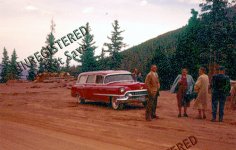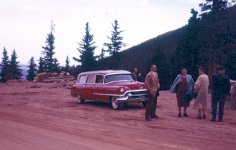pschauss
Well-known
I am scanning some 35 mm Ektachromes which my grandfather shot in 1956. As you can see from the attachment, the colors have faded and, possibly shifted (Is that the right term?). I have a copy of Photoshop Elements which came with the Epson V700 scanner that I am using. The Auto Color Correction option on the "Enhance" menu helps somewhat.
Is there anything better?
Is there anything better?
Attachments
charjohncarter
Veteran
I would go, after in PSE, go to enhance and reduce to 8 bit, and then find color cast and try to find something that would be white in the scene and then click on that to get something close and then further tweak.
Frankly I'm a little surprised at the color lose. This really seems extreme.
Here is a version I ran though a program I have for this. But this is probably a very under exposed slide with a lot of time poorly stored, this is what I got from a quick rework.
Frankly I'm a little surprised at the color lose. This really seems extreme.
Here is a version I ran though a program I have for this. But this is probably a very under exposed slide with a lot of time poorly stored, this is what I got from a quick rework.
Attachments
x-ray
Veteran
You probably won't be able to color correct to any acceptable degree. The magenta, cyan and yellow layers fade at different rates creating something you can't correct. You probably will get good results if you scan them as B&W or convert to B&W.
charjohncarter
Veteran
I'm still flummoxed by the way your Ektachromes have survived. I have many many that are as early as yours, but this is from, (it was easy to find), 1964:
 Ektachrome by carter3john, on Flickr
Ektachrome by carter3john, on Flickr
 Ektachrome by carter3john, on Flickr
Ektachrome by carter3john, on FlickrDNG
Film Friendly
I use the V700 with Epson Scan software, and I too had this issue... I used the Epson Color Space > sRBG ... Not "auto color correction" option in the config dialog.
and then I checked "Restore Photo" option, It popped back to almost perfect.
you may still need some color tweaking, but, it won't have red cast...
1964

CC14-Lr-1964 July-Margate PTA Parade-w JnPrDi-013 by 1921-2010: Photographic Archive: By Peter Arbib, on Flickr
and then I checked "Restore Photo" option, It popped back to almost perfect.
you may still need some color tweaking, but, it won't have red cast...
1964

CC14-Lr-1964 July-Margate PTA Parade-w JnPrDi-013 by 1921-2010: Photographic Archive: By Peter Arbib, on Flickr
astro8
Well-known
Dwig
Well-known
I'm still flummoxed by the way your Ektachromes have survived. I have many many that are as early as yours, but this is from, (it was easy to find), 1964:...
There is a MASSIVE difference in the dye stability between the Ektachromes of the mid-'50s and those of the early to mid-'60s.
Most of my family slide collection shows significant color fading and/or color shift in all E-2 class films, Kodak and others, that were shot in the '50s. By the early '60s the films became more stable. Pictures from 1962 onward in my collection show little shift. Kodachromes show very little or none all the way back to my earliest from 1948, and those are Kodachrome dupes as my mom's uncle kept the originals from that set.
dmr
Registered Abuser
Here's what I get from your example using levels and curves in Gimp.
I've done scans of 70s vintage Ektachromes and had reasonably good results, on both those which have faded to magenta and faded to cyan.
Your example appears to be very weak on the cyan side. I tried to compensate by bumping up the green saturation but it had very little visible effect. The best I seem to be able to do lacks any blue in the sky and still leaves the trees dark greenish-grey.
I've done scans of 70s vintage Ektachromes and had reasonably good results, on both those which have faded to magenta and faded to cyan.
Your example appears to be very weak on the cyan side. I tried to compensate by bumping up the green saturation but it had very little visible effect. The best I seem to be able to do lacks any blue in the sky and still leaves the trees dark greenish-grey.
Attachments
cmc850
Established
Each successive iteration of the Ektachrome process, ending at E-6, improved stability, but of course storage conditions and processing quality has a big effect. Some finishers used reduced wash cycle length or exhausted stabilizer. E-6 processing is relatively simple so was carried out by many labs and individuals, with varying quality.
Kodachrome is an entirely different animal, complex enough that few labs beyond Kodak's own could process it. The resulting transparencies were far more color-stable, especially when dark-stored than were Ektachrome of any variety. The dye layers of E-films are incorporated in the emulsion at manufacture, whereas Kodachrome consists of color-sensitive individual monochrome layers that are dyed with very stable dyes.
Kodachrome is an entirely different animal, complex enough that few labs beyond Kodak's own could process it. The resulting transparencies were far more color-stable, especially when dark-stored than were Ektachrome of any variety. The dye layers of E-films are incorporated in the emulsion at manufacture, whereas Kodachrome consists of color-sensitive individual monochrome layers that are dyed with very stable dyes.
pschauss
Well-known
Kodachrome is an entirely different animal, ...
Agreed. The Kodachrome slides that I found in the same box looked much better.
Thanks for all of the suggestions.
DNG
Film Friendly
@cmc850
I agree here with processing... most my Dads Ecktachomes where done by Kodak... those held up better than those at local labs...
He also shot Ansco Slide film, in the 60's, they seemed to fad more to the blue side...
Kodachrome's held up very well...
all where stored in closets in a air-conditioned home, and later after his retirement, in boxes in air-conditioned indoor storage units.
I agree here with processing... most my Dads Ecktachomes where done by Kodak... those held up better than those at local labs...
He also shot Ansco Slide film, in the 60's, they seemed to fad more to the blue side...
Kodachrome's held up very well...
all where stored in closets in a air-conditioned home, and later after his retirement, in boxes in air-conditioned indoor storage units.
charjohncarter
Veteran
There is a MASSIVE difference in the dye stability between the Ektachromes of the mid-'50s and those of the early to mid-'60s.
Most of my family slide collection shows significant color fading and/or color shift in all E-2 class films, Kodak and others, that were shot in the '50s. By the early '60s the films became more stable. Pictures from 1962 onward in my collection show little shift. Kodachromes show very little or none all the way back to my earliest from 1948, and those are Kodachrome dupes as my mom's uncle kept the originals from that set.
You are probably right; here is a 1937 Kodachrome from my father-in-law straight scan:
 1937 by carter3john, on Flickr
1937 by carter3john, on Flickrand just color correction with PSE;
 1937-k44 by carter3john, on Flickr
1937-k44 by carter3john, on FlickrAlso, just a few years later from him again in 1941; Kodachrome (straight scan):
 Kodachrome 1940-1941 by carter3john, on Flickr
Kodachrome 1940-1941 by carter3john, on Flickr
Share:
-
This site uses cookies to help personalise content, tailor your experience and to keep you logged in if you register.
By continuing to use this site, you are consenting to our use of cookies.


![slides_050%20copy[1]_edited-1.jpg](/data/attachments/48/48611-03e69c6597d0e23968c14aa59bf334a3.jpg)

